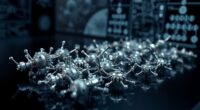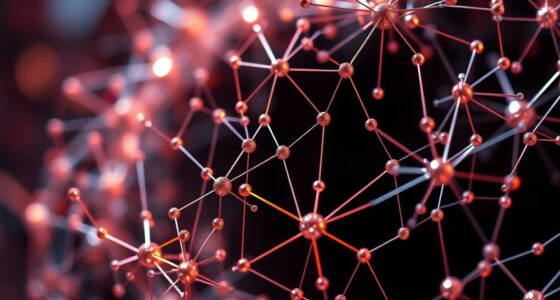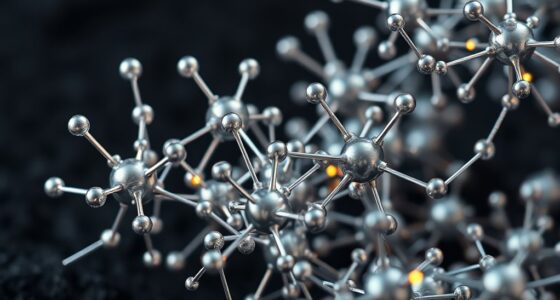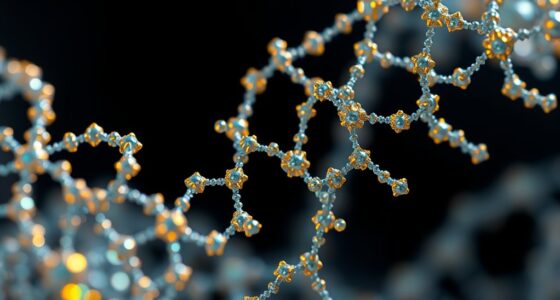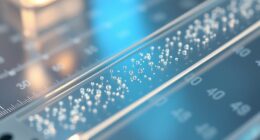Nanomachines are tiny devices built at the atomic and molecular level that perform precise tasks, using quantum effects, molecular interactions, and advanced materials like graphene and nanoparticles. They operate through energy sources such as chemical reactions or external fields, controlled by signals like light or magnetic forces. Their applications span medicine, manufacturing, and environmental cleanup. If you explore further, you’ll discover how these innovations are shaping the future of technology and society.
Key Takeaways
- Nanomachines are tiny devices built from molecules or nanomaterials designed to perform specific tasks at the atomic level.
- They operate using quantum effects, molecular interactions, and biochemical energy sources like ATP.
- Their applications include targeted drug delivery, environmental cleanup, advanced manufacturing, and sensors.
- Control mechanisms involve external fields, chemical signals, light, or temperature, ensuring precise functionality.
- Understanding nanomachines is crucial for technological advancement and addressing ethical, safety, and environmental challenges.
What Are Nanomachines and How Are They Made?
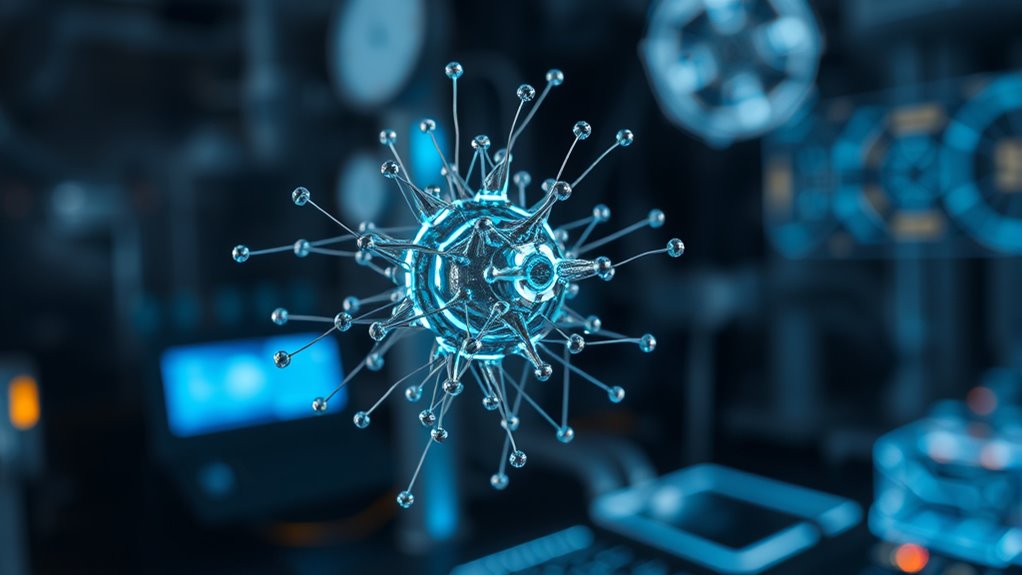
Nanomachines are tiny devices, often just a few nanometers in size, designed to perform specific tasks at the molecular level. You can think of them as microscopic machines built with precision, using various methods. Scientists typically create nanomachines through bottom-up approaches, assembling molecules and atoms into desired structures, or top-down processes, etching larger materials down to the nanoscale. They utilize techniques like chemical synthesis, self-assembly, and advanced lithography. The materials involved include carbon-based structures like graphene, metal nanoparticles, and polymers. The goal is to produce devices with specific functions, such as moving, sensing, or reacting in controlled ways. These tiny machines are carefully designed at the atomic level to guarantee they perform their intended tasks efficiently and reliably, often leveraging high-precision fabrication techniques to achieve their complex structures.
The Science Behind Nanomachine Functionality
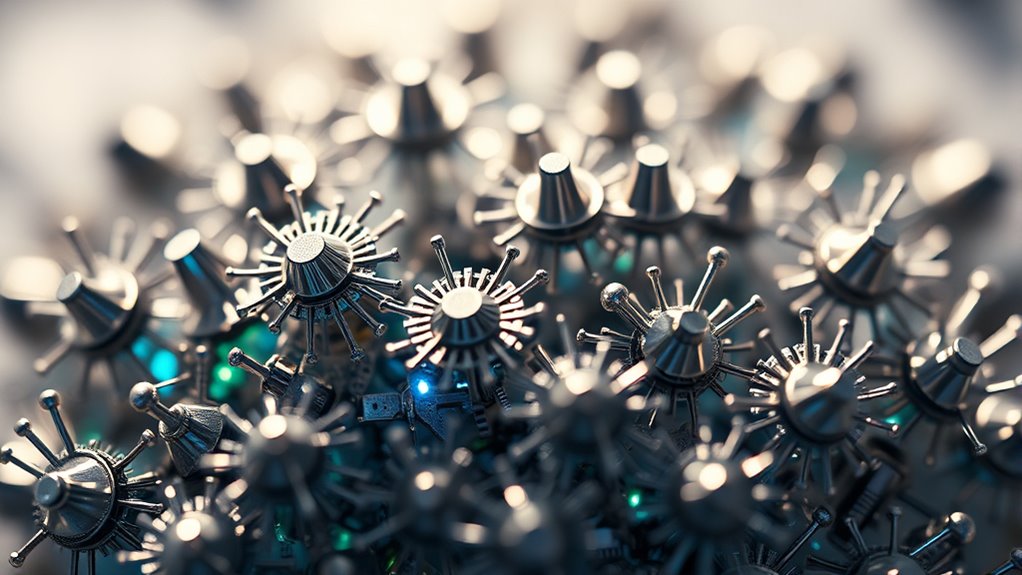
Understanding how nanomachines work requires exploring the fundamental science that governs their behavior. At this tiny scale, classical physics gives way to quantum mechanics, meaning particles behave differently than they do in larger objects. You’ll find that nanomachines rely heavily on molecular interactions, such as hydrogen bonding, van der Waals forces, and electrostatic attractions. These forces enable them to perform precise movements and tasks. Additionally, proteins and DNA are often used as natural scaffolds, guiding motion and function. Energy transfer occurs through controlled chemical reactions, often driven by ATP or other molecules. Resources and Tools provide valuable insights into the materials and techniques used in nanomachine development. This combination of quantum effects, molecular interactions, and biochemical energy allows nanomachines to operate efficiently, accurately, and with remarkable specificity, making them essential tools in medicine, electronics, and material science.
Types of Nanomachines and Their Applications
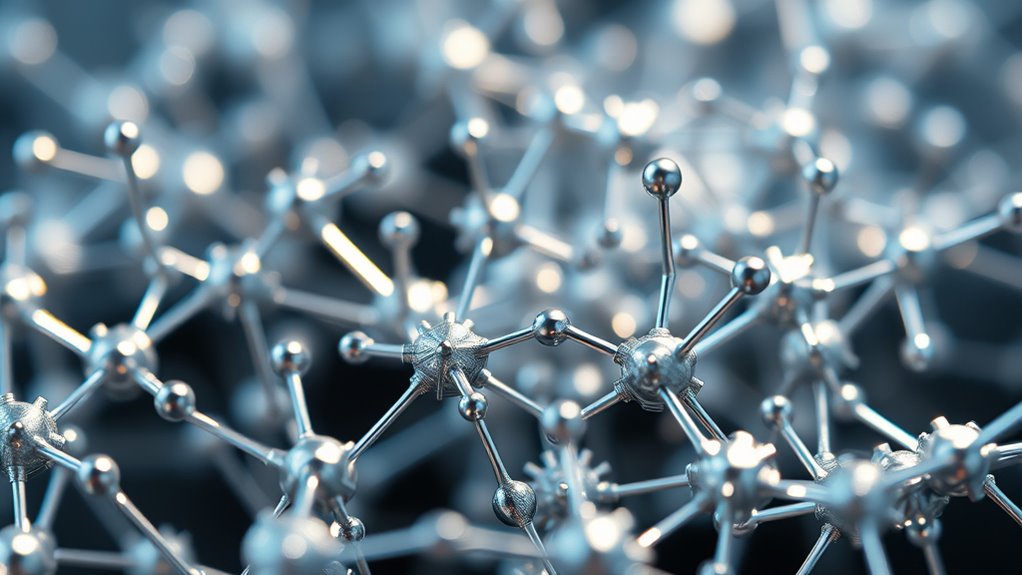
Have you ever wondered about the different types of nanomachines and how they’re used across various fields? Nanomachines come in many forms, each designed for specific tasks. Some are molecular motors that generate movement, while others are drug delivery systems that target cells precisely. Researchers also develop nanoscale sensors to detect environmental changes or disease markers. Additionally, nanomachines are used in manufacturing, helping create stronger, lighter materials. Cookies and data management are essential for optimizing user experiences and enabling personalized applications in nanotechnology. Here are some common types and their uses:
Nanomachines include molecular motors, drug carriers, sensors, and nanomaterials transforming medicine and industry.
- Molecular motors for transportation within cells
- Drug delivery nanocarriers for targeted medicine
- Nanosensors for diagnostics and environmental monitoring
- Nanomaterials for enhanced strength and conductivity
These diverse nanomachines revolutionize industries, improve health care, and push technological boundaries.
How Nanomachines Are Controlled and Powered

You can power nanomachines with sources like chemical reactions, electrical energy, or light. Control is achieved through mechanisms such as magnetic fields, chemical signals, or electrical inputs. Signal transmission methods include wireless communication or direct chemical interactions, allowing precise operation at the nanoscale.
Power Sources Utilized
How do nanomachines get the energy they need to perform their tasks? They rely on various innovative power sources tailored for their tiny size. Some utilize chemical reactions, converting energy from molecules like ATP or other fuels into usable power. Others harness external energy, such as light or magnetic fields, to activate movement. In some cases, nanomachines are powered by electrical currents supplied through nanoscale electrodes. Researchers are also exploring biological energy transfer methods, where nanomachines tap into cellular processes. These diverse sources ensure nanomachines can operate efficiently in different environments and for various functions. Additionally, energy transfer mechanisms within biological systems can be mimicked to enhance nanomachine efficiency and adaptability.
Control Mechanisms Employed
Nanomachines are controlled through a variety of precise mechanisms that enable them to perform specific tasks accurately. You might use external stimuli like magnetic or electric fields to guide their movements, allowing for targeted actions without direct contact. Some nanomachines respond to chemical signals, activating only in specific environments or when certain molecules are present. Others rely on temperature changes or light to initiate movement or function. These control methods provide high precision, making nanomachines adaptable for different tasks. By carefully designing these mechanisms, you guarantee that nanomachines operate only when needed, with minimal unintended activity. This level of control is essential for applications ranging from medicine to manufacturing, where accuracy and reliability are vital. Understanding control mechanisms is essential for advancing nanotechnology.
Signal Transmission Methods
What powers and controls these tiny devices? Signal transmission methods are key to controlling nanomachines. They rely on various techniques to communicate and respond to commands. Some use electromagnetic signals, like radio waves or magnetic fields, to send instructions wirelessly. Others depend on chemical signals, mimicking biological processes, where molecules trigger specific actions. Optical signals, such as laser pulses, can activate or guide nanomachines with precision. Additionally, electrical signals delivered through nanoscale electrodes enable direct control. These methods allow nanomachines to operate autonomously or under external guidance. By understanding and employing these transmission techniques, researchers can design nanomachines that function efficiently within complex environments. This control is essential for applications like targeted drug delivery, environmental sensing, and nanoscale manufacturing. Maximize space and organization
The Role of Nanomachines in Medicine

Nanomachines hold immense promise for revolutionizing medicine by enabling targeted and minimally invasive treatments. They can navigate through your body to deliver drugs directly to affected cells, reducing side effects and increasing effectiveness. For example, nanomachines can seek out cancer cells and release medication precisely where it’s needed, avoiding healthy tissue. They also assist in repairing tissues at a cellular level, promoting faster healing. Additionally, nanomachines can detect early signs of diseases by monitoring biological markers, allowing for earlier intervention. Their ability to operate at such a small scale makes them ideal for complex medical tasks that traditional methods can’t accomplish. This level of precision enhances conflict resolution skills in treatment delivery, leading to better patient outcomes. As research advances, you’ll see nanomachines become essential tools for personalized, efficient, and less invasive healthcare solutions.
Manufacturing and Environmental Uses of Nanomachines

Advancements in nanotechnology are transforming manufacturing processes and environmental management by enabling precise, efficient, and sustainable solutions. Nanomachines can create stronger, lighter materials, improve manufacturing accuracy, and reduce waste. They are also indispensable in cleaning up pollutants, breaking down hazardous substances, and monitoring environmental conditions at a microscopic level. With their ability to operate at nanoscale, you can develop self-healing materials and smarter filtration systems that adapt to changing conditions. These innovations lead to cost savings, increased safety, and less environmental impact. As you explore these applications, you’ll see how nanomachines pave the way for eco-friendly manufacturing and more effective environmental protection. Nutritional benefits of certain nanomaterials are also being researched for their potential in health-related applications.
Challenges and Ethical Considerations in Developing Nanotech
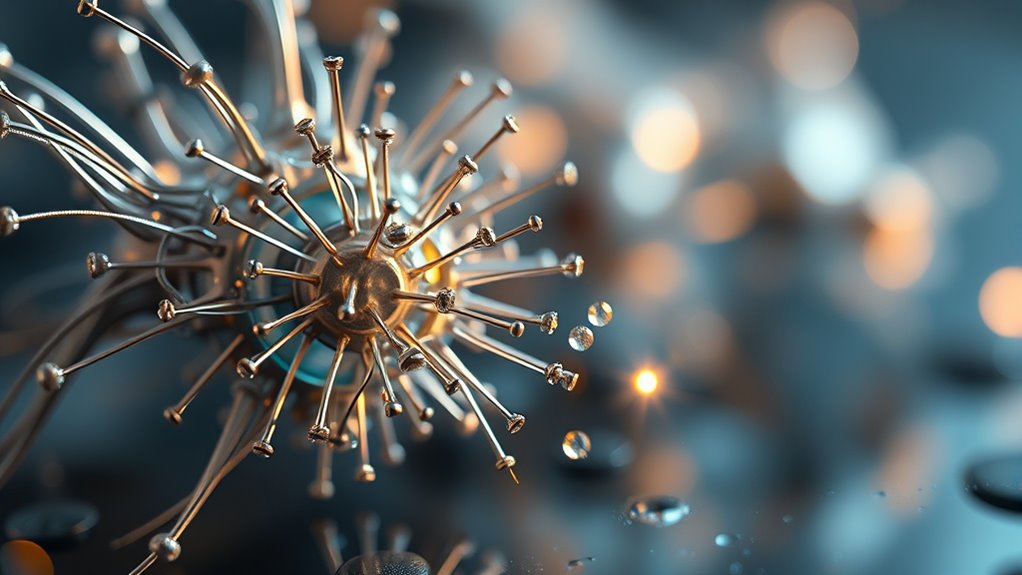
As the development of nanotechnology accelerates, challenges related to safety, regulation, and ethical concerns become increasingly important to address. You need to contemplate potential risks like toxicity, environmental impact, and unintended consequences. Regulation must keep pace with innovation to prevent misuse or accidents. Ethical issues include privacy, consent, and potential misuse of powerful nanomachines. Balancing progress with responsibility is critical. Below is a table highlighting key ideas:
| Challenge | Ethical Considerations |
|---|---|
| Safety and toxicity | Privacy and surveillance |
| Regulation and oversight | Dual-use technology concerns |
| Environmental impact | Human enhancement debates |
Future Prospects and Innovations in Nanomachine Technology
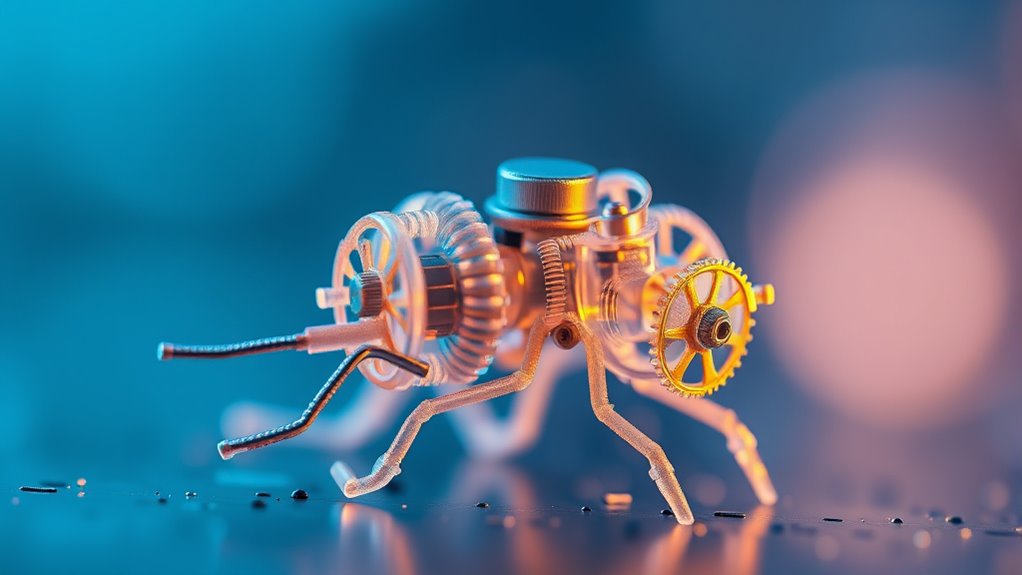
You’ll see that emerging design trends are making nanomachines more versatile and efficient. These innovations could disrupt industries like medicine, manufacturing, and energy. Staying informed about these developments helps you understand how nanotech might reshape the future. For example, advances in beach town tourism infrastructure demonstrate how technological progress can enhance leisure experiences and local economies.
Emerging Design Trends
Emerging design trends in nanomachine technology are shaping a future where these tiny devices become more sophisticated, adaptable, and integrated into everyday applications. Researchers are focusing on enhancing precision, enabling nanomachines to perform complex tasks with minimal energy. There’s a push toward developing self-assembly techniques, allowing nanomachines to build and repair themselves automatically. Materials are evolving to include biocompatible and sustainable options, expanding potential uses in medicine and environmental monitoring. Additionally, integration with artificial intelligence is promising smarter, autonomous nanomachines that can make real-time decisions. These trends aim to make nanomachines more versatile and reliable.
- Use of smart materials for adaptability
- Advanced self-assembly and repair methods
- Increased biocompatibility and sustainability
- Integration with AI for autonomy
Potential Industry Disruptions
Nanomachine technology is poised to revolutionize multiple industries by enabling unprecedented levels of precision, efficiency, and automation. You’ll see dramatic changes in healthcare, manufacturing, and environmental management as nanomachines perform tasks at a microscopic scale. This innovation could lead to targeted drug delivery, cleaner energy production, and smarter materials. As industries adapt, traditional practices may become obsolete, creating new markets and opportunities.
| Industry | Disruption Potential |
|---|---|
| Healthcare | Precise diagnostics and personalized treatments |
| Manufacturing | Ultra-fine assembly and defect detection |
| Energy | Efficient energy harvesting and storage |
| Environment | Pollution cleanup and resource monitoring |
The Impact of Nanomachines on Society and Industry
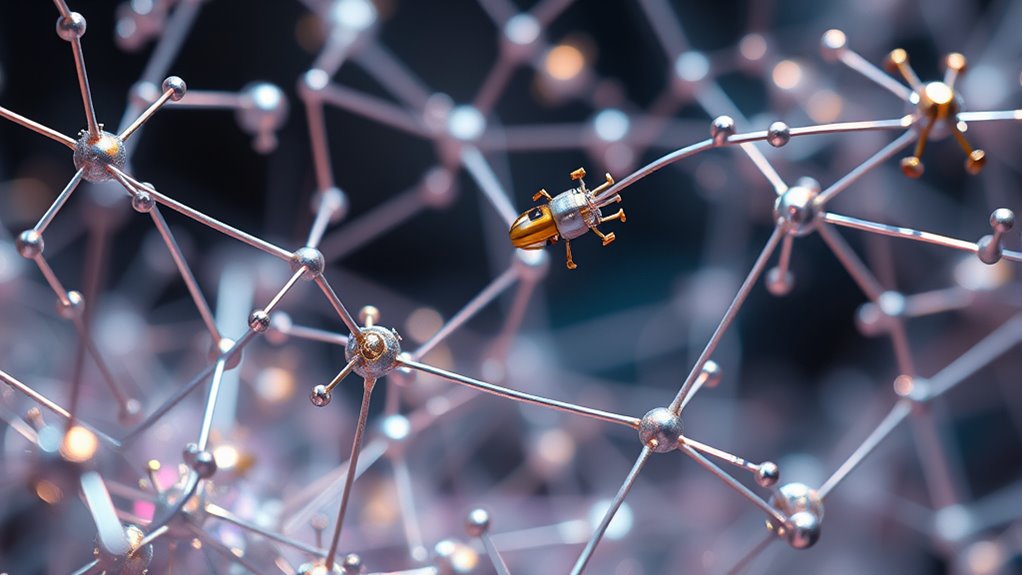
As nanomachines become more integrated into various sectors, their impact on society and industry is increasingly profound. You’ll see improvements in healthcare, manufacturing, and environmental management. They enable precise drug delivery, leading to better treatments and fewer side effects. In industry, nanomachines streamline production, reduce waste, and enhance material strength. Society benefits through cleaner environments, safer products, and innovative solutions to global challenges. However, ethical concerns and safety risks also emerge, requiring careful regulation. As you witness these changes, it’s clear nanomachines will reshape daily life and economic systems. They hold the potential to make industries more efficient and society more sustainable. Embracing this technology involves balancing innovation with responsibility to maximize benefits and minimize risks.
- Advances in medicine and healthcare
- Improved manufacturing processes
- Environmental cleanup and pollution control
- Ethical considerations and safety regulations
Frequently Asked Questions
How Safe Are Nanomachines for Human Health and the Environment?
Nanomachines are generally considered safe when properly designed and regulated, but potential risks remain. You should be cautious, as some nanomaterials might cause health issues or environmental damage if released improperly. Researchers are working to develop safer, biodegradable nanomachines, and strict safety standards are essential. Stay informed about new regulations and advancements to ensure their use safeguards both your health and the environment.
What Are the Major Technical Limitations Currently Facing Nanomachine Development?
You face major technical limitations in nanomachine development, like controlling their movement precisely at such tiny scales, ensuring stability and avoiding unintended interactions. Manufacturing these machines consistently and cost-effectively remains a challenge, as does powering them reliably. Additionally, developing materials that can withstand operational stresses while maintaining functionality is tough. Overcoming these hurdles will be vital for advancing nanomachines from research to practical applications successfully.
Can Nanomachines Malfunction or Be Hacked, and What Are the Risks?
Did you know that up to 60% of cybersecurity breaches involve some form of device manipulation? Nanomachines can malfunction or be hacked, posing significant risks like unintended drug release or environmental harm. You should be cognizant that their tiny size makes them vulnerable to external control, especially if security isn’t robust. Proper safeguards are essential to prevent malicious interference and ensure these powerful tools operate safely and effectively.
How Affordable and Accessible Will Nanotech Solutions Become in Everyday Life?
Nanotech solutions will become more affordable and accessible as technology advances and production costs decrease. You’ll likely see these innovations integrated into everyday items, from healthcare to household goods, making life easier and more efficient. As companies compete and scale up manufacturing, prices will drop, allowing you to benefit from nanotech’s potential without breaking the bank. Expect a future where nanotechnology is seamlessly woven into your daily routine.
What Regulations Are in Place for the Ethical Use of Nanomachines?
Regulations for the ethical use of nanomachines vary globally, but generally, governments and organizations set strict guidelines to guarantee safety and prevent misuse. You should stay informed about local laws, which often include safety testing, approval processes, and restrictions on certain applications. Researchers and developers are encouraged to follow ethical standards, prioritize transparency, and conduct thorough risk assessments to protect public health and privacy.
Conclusion
As you explore nanomachines, remember they could revolutionize industries—by 2030, it’s estimated that nanotech could add over $3 trillion to the global economy. This technology’s potential to transform medicine, manufacturing, and environmental protection is immense, but it also raises ethical questions. Staying informed and involved will help you navigate this exciting future, ensuring nanomachines benefit society responsibly and sustainably. The future is in your hands—embrace the possibilities today.

